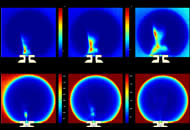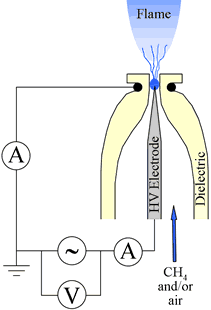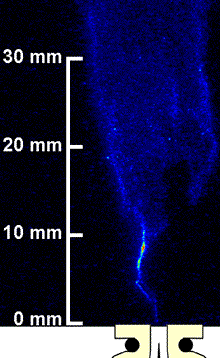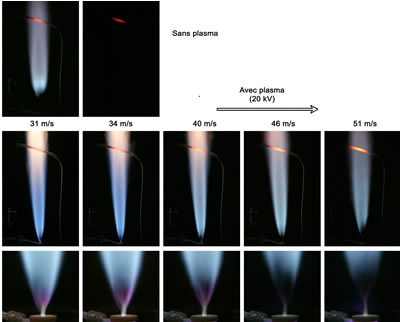Plasmas can initiate and accelerate combustion in engines and turbines. Their experimental study on test benches aims to improve the understanding of the involved phenomenon and to optimize it.
Numéro 40
 Synchronized images of emissions of the N2 and CH chemical species from the interaction of a flame with a plasma discharge. |
Plasmas are already present in some of our television sets. One day, they could appear in our cars engines or aircraft jet engines. Their function is to improve the combustion. A plasma is a partially ionized gas, i.e. the electrons of certain molecules have been ejected1. "The plasma makes the fuel more reactive, which means that engines can be run at speeds at which they are usually unstable" explains Axel Vincent, a researcher in the Onera's Fundamental and Applied Energetics Department at Palaiseau. |
| The plasma facilitates the fuel ignition, accelerates the combustion, prevents surges and hunting and improves the combustion homogeneity. In brief, it works as a combustion catalyst. Possible applications include: the use of lean fuel mixes in order to reduce the emission of pollutants (particularly nitrogen oxides), the running of micro-turbines2, the improvement of supersonic combustion. The plasma facilitates the fuel ignition, accelerates the combustion, prevents surges and hunting and improves the combustion homogeneity. In brief, it works as a combustion catalyst. Possible applications include: the use of lean fuel mixes in order to reduce the emission of pollutants (particularly nitrogen oxides), the running of micro-turbines2, the improvement of supersonic combustion. |
 The injector is equipped with a system of electrodes used to generate the plasma in the flame. |
| However, before we can use plasmas in engines and turbines, we need to get a better understanding of how they influence combustion. Does the plasma work by chemical reactions, by raising the temperature or by hydrodynamic modification of the flows? These studies are at the frontiers of at least two disciplines: the science of combustion and the physical chemistry of plasmas. Multiple means of analysis are needed to study both the electrical discharges and the resulting physical chemistry. Température de flamme avec plasmaVisualization of the interaction of a flame with a plasma filament, by measuring the intensity of the light emission. |
|
 Visualization of the interaction of a flame with a plasma filament, by measuring the intensity of the light emission. |
This is why Onera designed a specialized test bench, with adapted means of analysis: "we create images with an extremely short exposure time (a few nanoseconds) in order to visualize the interaction between the discharge and the flame". These measurements are backed up by numerical simulations. Result: "though the thermal effect seems the most important, the role of the chemical reactivity cannot be ignored: the two effects are coupled and that is what makes them more effective", he stresses. |
|
The next step is to implement a plasma system on existing combustion test benches of a larger size. Up to now, the studies have concentrated on flames with a power of about one kilowatt and now the transition must be made to a larger scale, 100 kW, or even one megawatt, closer to the characteristics of aircraft engines. In addition, research carried out on a real combustion chamber should enable the researchers to analyze the products of combustion, in order to evaluate the effect of the plasma on the amount of pollutant emissions. "If we demonstrate the relevance of plasma technology in combustion chambers of representative size, applications could quickly become a reality".
|
|
|
Video showing the behavior of a diffusion flame and its working limits "without" then "with" plasma assistance. Note the increase in the blow-off velocity of around 50 % (meaning that the same amount of extra power is produced by the combustion).
|
|
|
Cécile Michaut, scientific reporter. |
|





